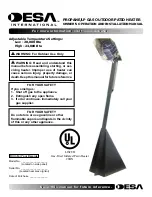
9
INSULATION BLANKETS
Do not obstruct water heater air intake
with insulating blanket.
Gas and carbon monoxide detectors
are available.
Install water heater in accordance with
the instruction manual.
Breathing carbon monoxide can cause brain damage or
death. Always read and understand instruction manual.
Breathing Hazard - Carbon Monoxide Gas
Insulation blankets are available to the general public for
external use on gas water heaters but are not necessary
with these products. The purpose of an insulation blanket is
to reduce the standby heat loss encountered with storage
tank heaters. The water heaters covered by this manual meet
or exceed the Energy Policy Act standards with respect to
insulation and standby heat loss requirements, making an
insulation blanket unnecessary.
Should you choose to apply an insulation blanket to this heater,
you should follow these instructions. See the Installation
Considerations section of this manual for identification
of components mentioned below. Failure to follow these
instructions can restrict the air flow required for proper
combustion, potentially resulting in fire, asphyxiation, serious
personal injury or death.
•
DO NOT
apply insulation to the top of the water heater, as
this will interfere with safe operation of the draft hood.
•
DO NOT
cover the thermostat or the Temperature-
Pressure Relief Valve.
•
DO NOT
allow the insulation to come within 2 inches (5
cm) of the floor to prevent blockage of combustion air flow
to the burner.
•
DO NOT
cover the instruction manual. Keep it on the side
of the water heater or nearby for future reference.
•
DO
obtain new warning and instruction labels from the
manufacturer for placement on the blanket directly over
the existing labels.
•
DO
inspect the insulation blanket frequently to make
certain it does not sag, thereby obstructing the
combustion air flow.
HARD WATER
Where hard water conditions exist, water softening or the threshold
type of water treatment is recommended. This will protect the
dishwashers, coffee urns, water heaters, water piping and other
equipment. See the Maintenance Section in this manual for
sediment and lime scale removal procedures.
CIRCULATION PUMPS
A circulating pump is used when a system requires a circulating
loop or there is a storage tank used in conjunction with the
water heater. See Water Piping Diagrams in this manual for
installation location of circulating pumps.
See the Circulation Pump Wiring Diagrams below for electrical
hookup information. Install in accordance with the current
edition of the National Electrical Code, NFPA 70 or the
Canadian Electrical Code, CSA C22.1.
All bronze or stainless steel circulating pumps are recommended
for used with commercial water heaters.
Some circulating pumps are manufactured with sealed bearings
and do not require further lubrication. Some circulating pumps
must be periodically oiled. Refer to the pump manufacturer’s
instructions for lubrication requirements.
CIRCULATING PUMP WIRING DIAGRAM
STORAGE TANK OR BUILDING RECIRCULATION
FIELD SUPPLIED TEMPERATURE CONTROL
INSTALLED IN THE STORAGE TANK
OR CIRCULATING LOOP RETURN LINE
CIRC
PUMP
MOTOR
L1 HOT
L2 NEUTRAL
120 VAC
POWER
NOTE:
USE SEPARATE 120 VAC POWER
SUPPLY FOR PUMP CIRCUIT. DO NOT
SHARE POWER WITH WATER HEATER AS THIS
MAY CAUSE ELECTRICAL LINE NOISE AND
LEAD TO ERRATIC CONTROL SYSTEM
OPERATION.
FIGURE 4.
CIRCULATING PUMP WIRING DIAGRAM
DISHWASHER LOOP WITH TOGGLE SWITCH
FIELD SUPPLIED TEMPERATURE
CONTROL INSTALLED IN THE
CIRCULATING LOOP RETURN LINE
DISHWASHER
TOGGLE
SWITCH
CIRC
PUMP
MOTOR
L1 HOT
L2 NEUTRAL
120 VAC
POWER
NOTE:
USE SEPARATE 120 VAC POWER
SUPPLY FOR PUMP CIRCUIT. DO NOT
SHARE POWER WITH WATER HEATER AS
THIS MAY CAUSE ELECTRICAL LINE NOISE
AND LEAD TO ERRATIC CONTROL SYSTEM
OPERATION.
FIGURE 5.










































